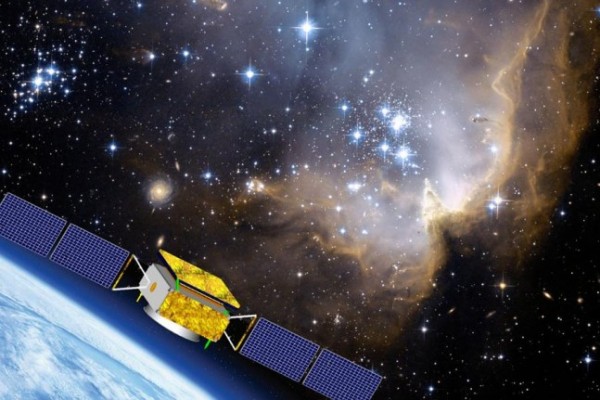【SCIENCE】China launches satellite to join the hunt for dark matter

Artist’s impression of DAMPE, the first of four purely scientific Chinese space missions
SHANGHAI, CHINA—China's space science efforts got a boost today with the launch of the first of four planned scientific missions. The Dark Matter Particle Explorer (DAMPE) rode into space on a Long March 2D rocket from the Jiuquan Satellite Launch Center in the Gobi desert, about 1600 kilometers west of Beijing, at about 8:12 a.m. local time.
"This is an exciting mission," says theoretical astrophysicist David Spergel of Princeton University. If dark matter annihilates, as some theories predict, "DAMPE has an opportunity to detect dark matter annihilation products," Spergel says. The launch also marks China’s new commitment to scientific space missions. "DAMPE is the first Chinese space mission for astronomy and astrophysics," says Yizhong Fan, an astrophysicist at the Chinese Academy of Sciences's (CAS's) Purple Mountain Observatory in Nanjing who is one of the mission scientists.
Dark matter is believed to make up most of the matter in the universe. But it has never been detected directly; its existence is inferred from observed gravitational effects on visible matter and the structure of the universe. DAMPE is designed to observe the incoming direction, energy, and electric charge of extremely high-energy photons and electrons that result when dark matter candidate particles called weakly interacting massive particles (WIMPs) annihilate. The satellite's payload is made up of a stack of thin criss-crossed strip detectors tuned to catch signals created by photons and electrons as well as gamma rays and cosmic rays.
"We are, of course, confident that DAMPE will contribute to the dark matter search," says Philipp Azzarello, a University of Geneva in Switzerland astrophysicist who collaborated in the design of DAMPE’s detector. Azzarello says the satellite improves on the energy range and resolution of previous space-based dark matter experiments. "The project is starting at an exciting time of intense searches for dark matter," agrees Vitaly Kudryavtsev, a particle physicist at the University of Sheffield in the United Kingdom who is also searching for dark matter. He says DAMPE will complement other space-based detectors as well as underground laboratories seeking to detect WIMPs directly.
The DAMPE collaboration comprises four institutes under CAS, including the National Space Science Center in Beijing; also involved are the University of Science and Technology of China in Hefei, the University of Geneva, and Italian universities in Bari, Lecce, and Perugia. The satellite has been named Wukong, after the Monkey King character in the 16th century Chinese novel
DAMPE is the first of four purely scientific satellites that add a new dimension to China's space efforts, which until now were strongly focused on engineering and applications. The Chang’e-3 lunar lander, launched in December 2013, investigated the moon’s surface topography and soil composition. And there were two previous scientific missions: the Geospace Double Star Exploration Program, developed with the European Space Agency and launched in 2004 to study Earth's magnetosphere; and a Mars probe, Yinghuo-1, launched on a Russian rocket in 2011, that failed to exit an Earth orbit.
But CAS’s 2011 Strategic Pioneer Program on Space Science has put research missions on a firmer footing. They are being managed by CAS's National Space Science Center (NSSC), which hopes to launch three more missions in 2016. One is the Hard X-ray Modulation Telescope to observe black holes, neutron stars, and other astronomical phenomena. NSSC and other CAS institutes are also working on a microgravity and life science research mission, dubbed Shijian-10, that features a re-entry capsule to return some of the experiments to Earth for analysis. There is also a satellite for quantum science experiments in the works. NSSC has set up a new mission control center for scientific satellites in Huairou, a northern suburb of Beijing.
"For sure, more [scientific missions] are to come," says Azzarello, who adds that he is looking forward to future opportunities to collaborate with China's growing space science program.


